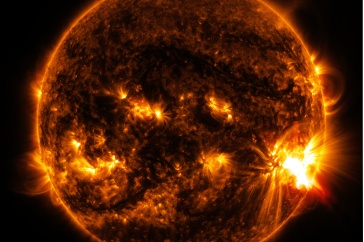
As carbon dioxide levels in our atmosphere continue to skyrocket, scientists are turning to the ocean and wondering: Just how much carbon can the seas hold? The answer has been elusive. Now, a new study published in the journal Nature offers the most accurate estimate to date of how much carbon dioxide is pulled out of the atmosphere and locked deep down in the ocean.
For the study, researchers from around the globe, including the University of New Hampshire, relied on an entirely different mathematical approach than in the past to arrive at their estimate of 8.25 petagrams, or billion metric tons, of carbon that gets pulled into the deep ocean each year. The study sheds light on the ocean’s biological carbon pump — the complicated series of processes mediated by marine plankton in which the ocean takes in carbon dioxide from the atmosphere and stores it for some period of time. By having a more accurate baseline number for the rate of carbon storage in the ocean, scientists will be better able to monitor changes over time.
“A unifying theme across the field of ocean biogeochemistry is that scientists are still trying to understand the global strength of the biological carbon pump,” says Robert Letscher, UNH assistant professor of Earth sciences in the Ocean Process Analysis Laboratory who is a co-author on the study. “We’ve been working on this for decades to figure out the carbon flux between the atmosphere and the deep ocean, and now we believe we finally have a good baseline number.”
Scientists have long estimated that number would fall somewhere between five and 12 petagrams, but that’s an incredibly large range, Letscher says. Those previous estimates either relied on satellite data of light reflectance from the ocean’s surface — there are no satellites that directly estimate carbon in the ocean, he explains — or water samples that were collected from select regions and then that number was scaled up for the entire globe, thus leading to the large potential range in the estimate.
The study’s authors took a very different approach, one that calculated the rate of carbon flux in its native unit to reduce possible element conversion errors when using the more commonly measured nitrogen, phosphorous or oxygen content of marine waters. In addition, their inverse mathematical model took “real-world data and then posed the question: What do the [biological] processes have to be to get this number? This way, you can infer what the carbon fluxes had to be to get the picture we observed in real life,” Letscher explains.
Letscher’s research specializes in dissolved organic carbon — the carbon that is suspended in the water column and moves around via ocean currents — which accounts for approximately 20% of the biological carbon pump. He served as a consultant on the study to provide his expertise on this subject. Recent advancements in the mathematical tools available and newly public decades-long seawater databases of marine chemistry also helped the study’s authors arrive at their estimate.
“In addition to providing the new global estimate, our model diagnoses regions of the world ocean where the vertical versus horizontal components of the biological carbon pump dominate,” Letscher adds. “This will be very useful for predicting future changes in its strength as well as any efforts to conduct marine carbon dioxide removal to mitigate the effects of climate change.”
Funding for this study was provided by the National Science Foundation and the U.S. Department of Energy.
The UNH Institute for the Study of Earth, Oceans, and Space (EOS) is UNH's largest research enterprise, comprising six centers with a focus on interdisciplinary, high-impact research on Earth and climate systems, space science, the marine environment, seafloor mapping and environmental acoustics. With approximately 100 principal investigators managing more than 400 individual grant awards, and with annual expenditures exceeding $95 million, EOS fosters an intellectual and scientific environment that advances visionary scholarship and leadership in world-class and graduate education.
-
Written By:
Rebecca Irelan | Institute for the Study of Earth, Oceans, and Space | rebecca.irelan@unh.edu | 603-862-0990

















































